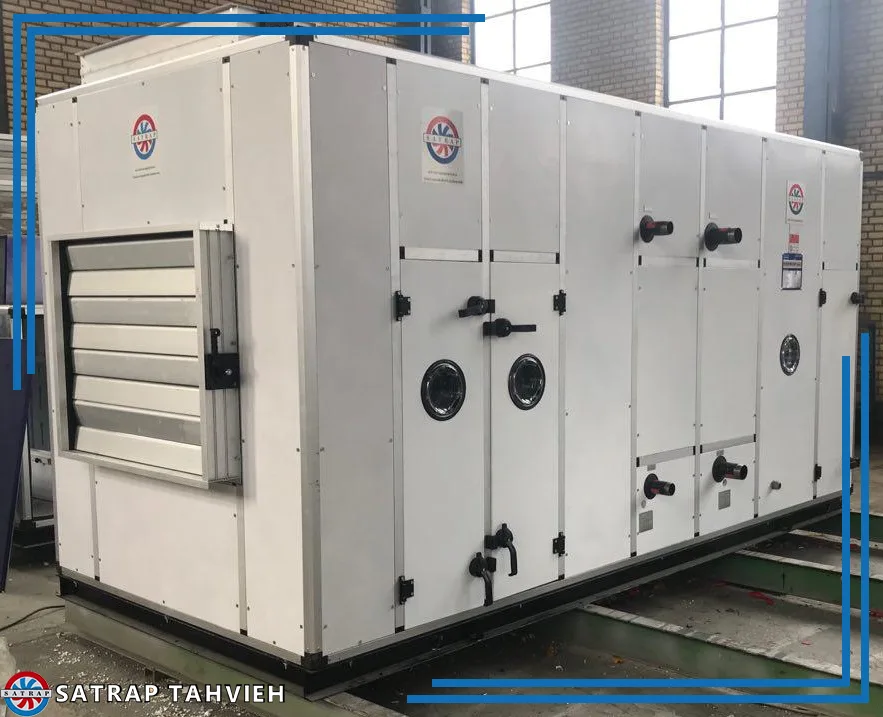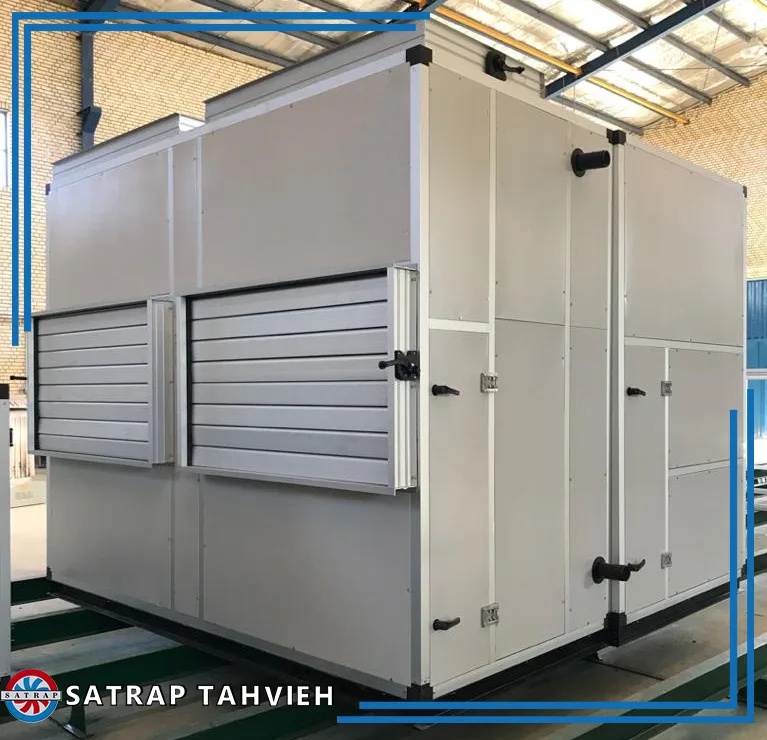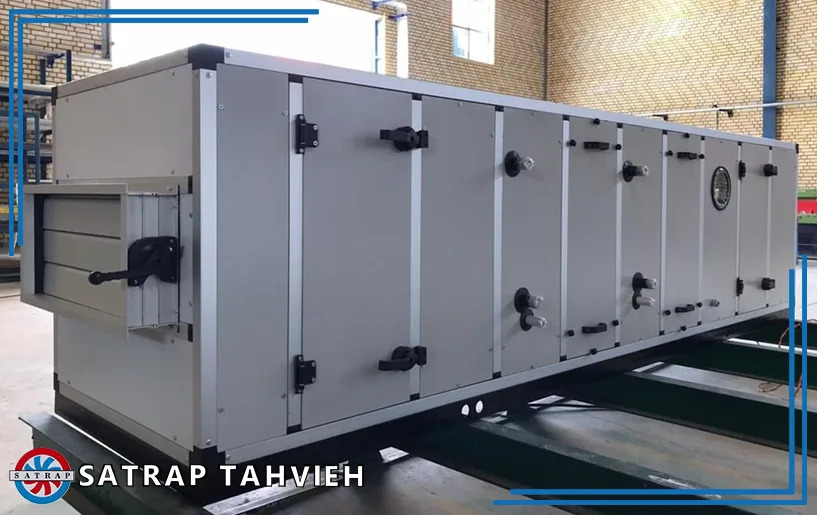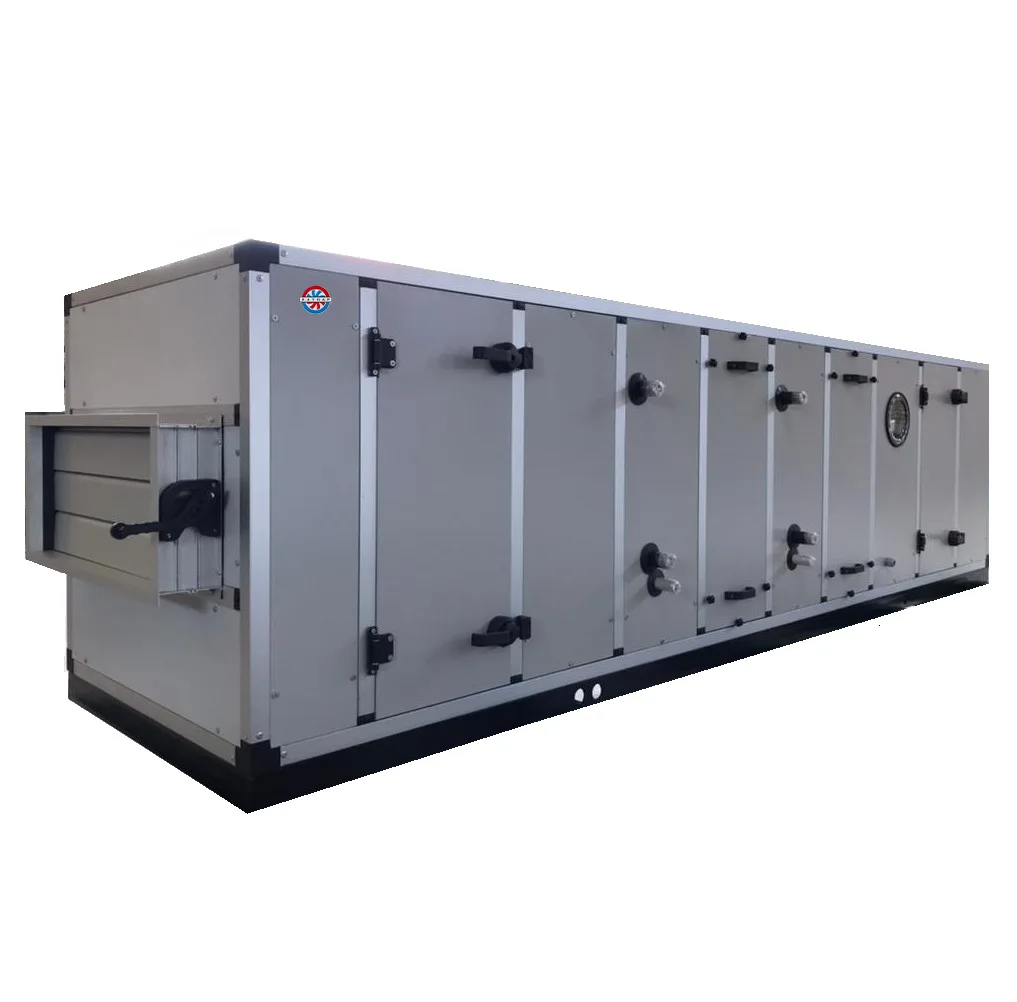Description
Air handling unit (AHU) is a device that filters, cools or heats, humidifies or dehumidifies, and distributes the supply air to a building at a desired velocity and direction in a uniform manner. In terms of application, it is divided into building air handling units (residential or office air handling units) and industrial air handling units.
Building Air Handling Unit
As mentioned earlier, air handling units can be broadly classified into two categories: building air handling units and industrial and commercial air handling units. Building air handling units can be used in various residential, office, educational, and other places, but for reasons mentioned below, their use is not recommended.
Structurally, there is no difference between these two types of air handling units, and the only differences are in their dimensions, the type of filters, humidification and dehumidification equipment, and the percentage of return air to the unit. For example, an industrial air handling unit operating in a polluted environment should preferably be equipped with special filters to absorb pollutants. Also, in a residential air handling unit, humidity control is important.
Residential air handling units are smaller models of building air handling units that usually do not have a humidification and dehumidification system. If needed, this system is installed separately. The hot water of the coils of residential air handling units is supplied by a gas boiler or boiler room boiler, and its cold water is supplied by an apartment mini-chiller.
It is noteworthy that the use of air handling units in residential and apartment applications is not recommended at all due to the disadvantages and problems it creates.
In residential and apartment applications (and even in office, educational, hotel, etc. applications that have multiple rooms with different temperature requirements), there are many rooms and the air temperature in each room must be able to be adjusted independently. However, in the air handling unit system, the cold or hot air discharged from the unit is distributed with a duct, and all rooms and halls are ventilated simultaneously at the same temperature. This is not suitable for residential projects.

Instead of using an air handling unit, it is recommended to use multiple fan coils (one for each room) to achieve individual temperature control in each room. Each fan coil can be turned off independently when ventilation is not required, which is one of the main advantages of fan coils.
Using a duct split system is also not recommended because, similar to an air handling unit, it distributes hot or cold air through ducts to all rooms, resulting in the same temperature throughout. Therefore, duct split systems are not suitable for spaces where individual temperature control is desired.
Air handling units should only be used in large, open spaces (such as industrial warehouses, single-unit halls like reception halls, cinemas, etc.) as industrial air handling units for cooling and heating.
Industrial Air Handling Unit (AHU)
An industrial air handling unit (AHU) is designed to provide ventilation for large industrial, warehouse, manufacturing, sports, and multi-purpose halls such as conference halls, cinemas, and banquet halls. Due to the vastness of these spaces, increasing the air circulation rate and using various filters is essential to save energy and prevent the entry or transmission of industrial pollutants. Overall, the operation of an industrial AHU is similar to its building type.
Main Components of an AHU:
Fan:
- Type: Centrifugal or axial
- Function: Draws in air and passes it through the coils
Coil:
- Material: Copper tube and aluminum fin
- Function: Transfers heat from the fluid to the air
- Types: Heating, cooling, DX
Filter:
- Types: Washable, HEPA, ULPA, borosilicate, activated carbon
- Function: Cleans the air and removes suspended particles
Humidifier and Dehumidifier:
- Function: Regulates the humidity of the air
Mixing Chamber:
- Function: Mixes fresh air with return air
Vibration Isolator:
- Function: Prevents vibration of the AHU system
Control Equipment:
- Includes thermostat, humidity controller, air velocity controller
- Function: Controls the operation of the AHU system
Duct:
- Function: Directs air into the building

Air Handling Unit (AHU) Applications
An air handling unit (AHU) is a device used to provide and transfer a suitable airflow for ventilation (providing fresh air), cooling (providing cool air), and heating (providing warm air) in a building.
The use of AHU in the ventilation system of a building or warehouse is usually necessary in one of the following conditions:
- In any application where there is a continuous need for fresh air supply.
- In any application with high traffic where sufficient oxygen must be provided.
- In any application where the air must be evenly distributed through ducts due to high ceiling height and large and single-piece hall.
- In places where the air must be completely and appropriately filtered.
- In places where the air humidity must be completely controlled and its amount can be adjusted.
Advantages and Disadvantages of AHU
As mentioned earlier, AHU is a device that after cooling, heating, filtering, and adjusting the air humidity, distributes it throughout the building using ductwork. Its advantages and disadvantages are in contrast to ductless systems such as fan coils.
In a fan coil system, a fan coil is considered for each room or part of the building. All fan coils are connected to the chiller and boiler (in industrial and commercial dimensions) or mini chiller and packaged unit (in residential, apartment, villa, etc.) with cold and hot water piping, and ductwork is no longer used.
The advantage of AHU over fan coils is that it can inject a large volume of fresh air into the building. This advantage ensures that the building’s air is always fresh and healthy.
AHUs are divided into two categories: ordinary and full fresh. In ordinary AHUs, part of the indoor air is replaced with fresh air. In full fresh AHUs, all the air passing through the device is supplied from outside the building.

Air Handling Unit Price
The price of an air handling unit (AHU) is usually determined based on the amount of air it can move (flow rate), measured in CFM (cubic feet per minute). This base price can increase with the addition of features such as dehumidifiers, humidifiers, and special filters.
Since each AHU must be designed and built to suit the specific needs of the location where it will be used, it is not possible to give an exact price for one. The price of an AHU will be determined after its capacity and technical specifications have been determined. To get an AHU price quote, you can contact our engineers at Satraptahvieh Alborz.
Buying a Standard AHU from Satraptahvieh Alborz
Satraptahvieh Alborz is a designer and manufacturer of various standard, hospital, hygienic or industrial and non-industrial AHUs and other HVAC equipment. We sell our products directly from the factory at a reasonable price after designing and manufacturing them. You can entrust us with all aspects of تجهیز اتاق تمیز your complex, including the installation of hygienic AHUs and selecting the most suitable device for your project. You can also contact our engineers to get a price quote for these products.



Reviews
There are no reviews yet.